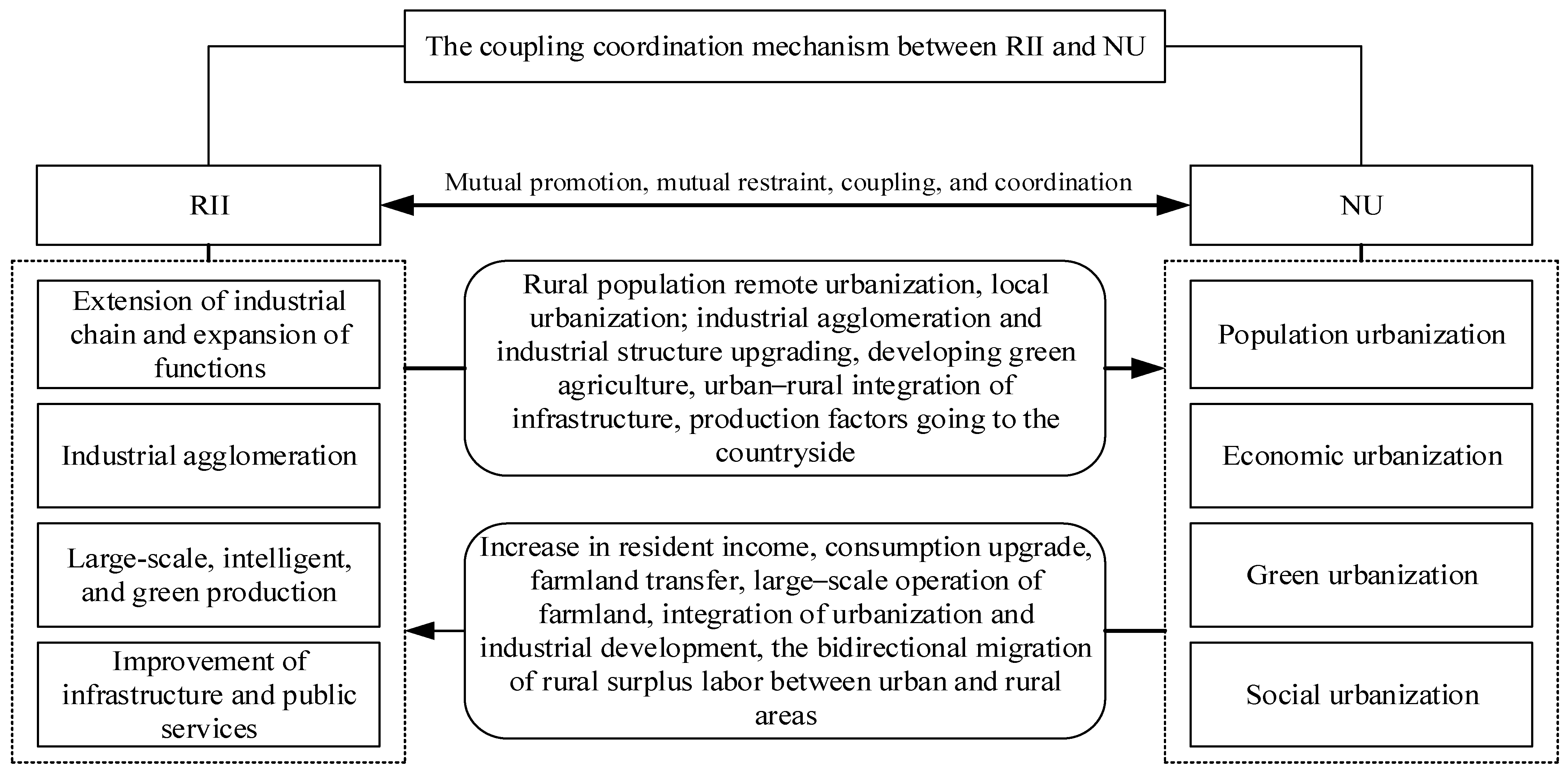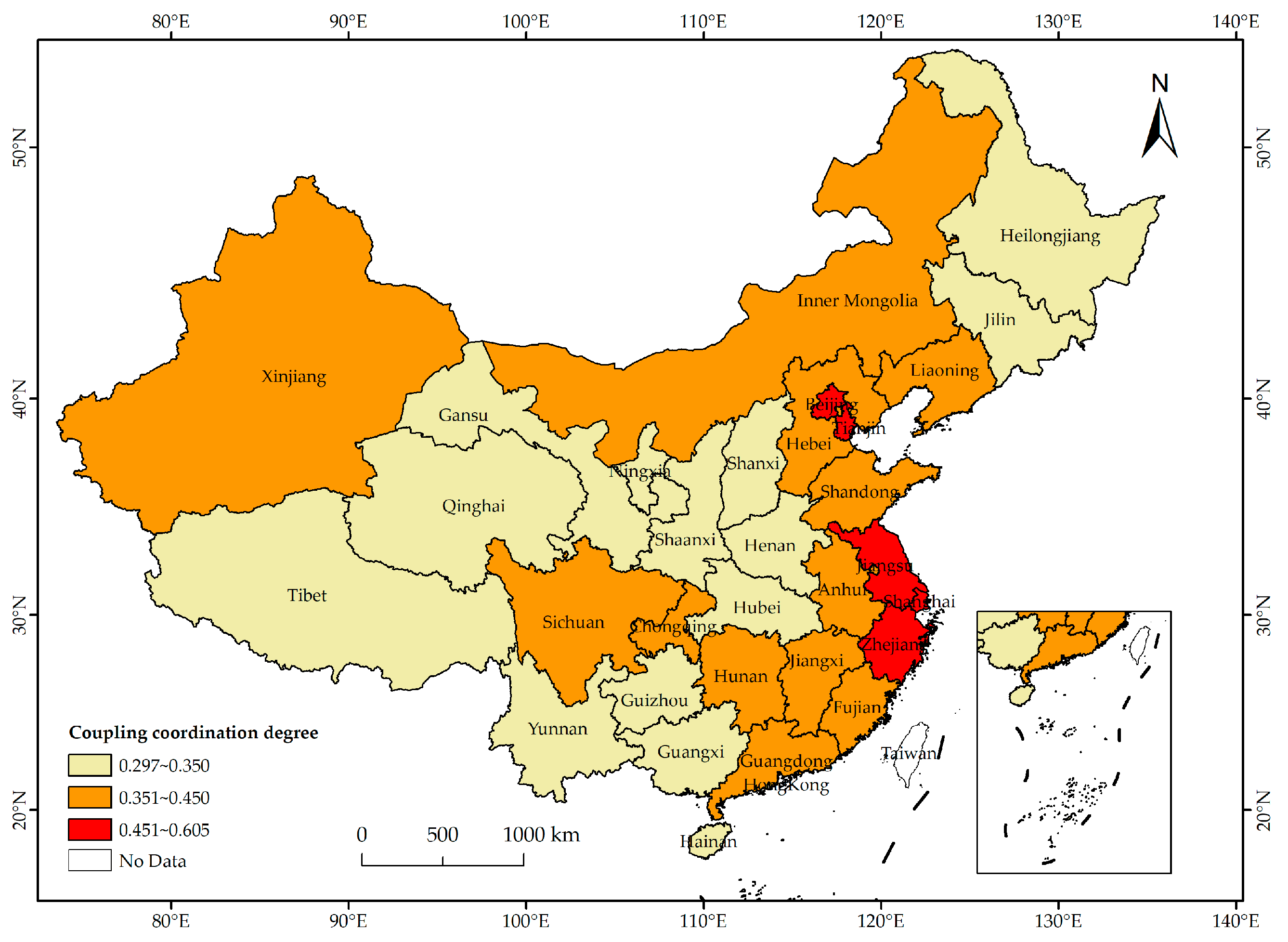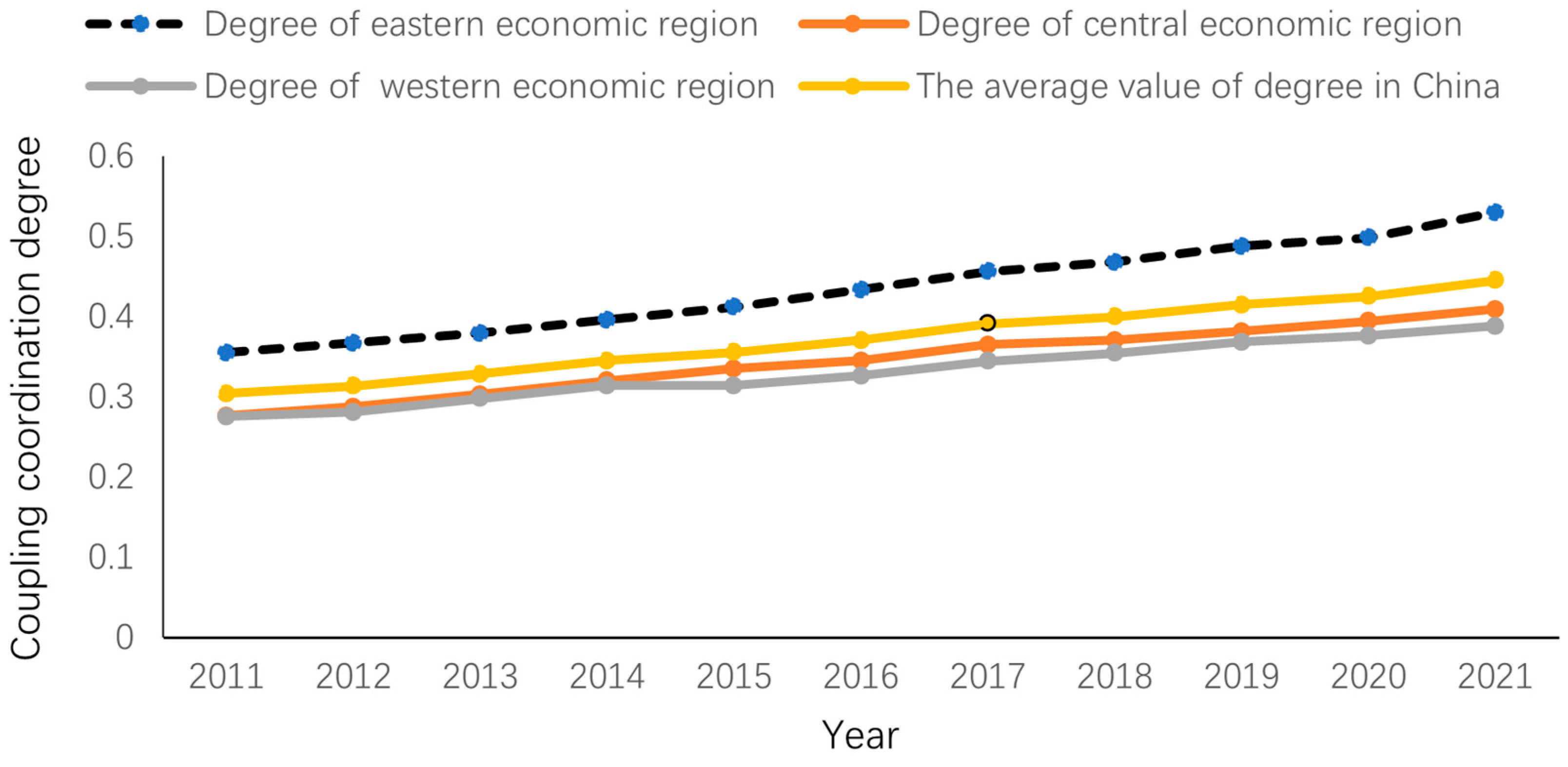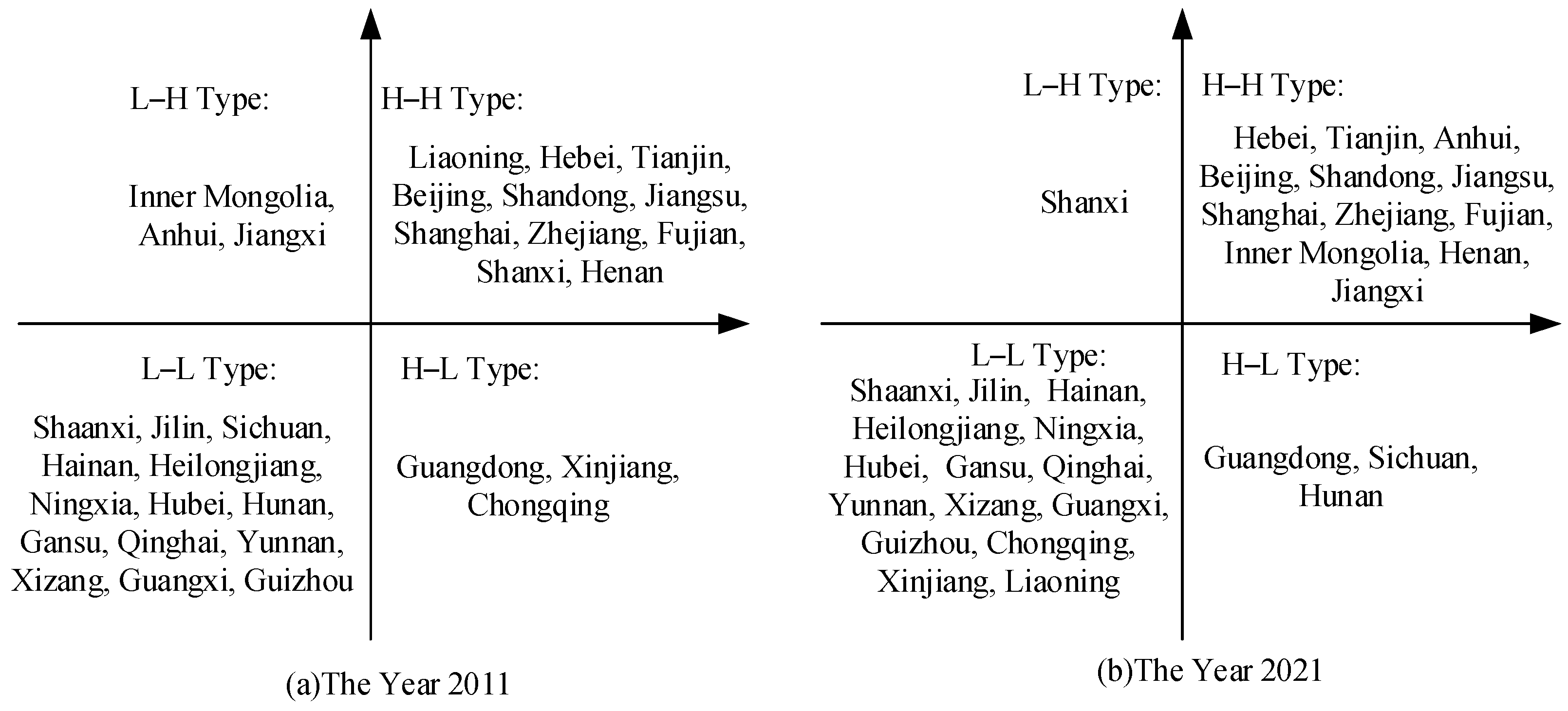Rural Industrial Integration and New Urbanization in China: Coupling Coordination, Spatial–Temporal Differentiation, and Driving Factors
Abstract
:1. Introduction
2. The Coupling Coordination Mechanism between RII and NU
2.1. The Influence of RII on NU
2.2. The Influence of NU on RII
3. Research Methodology and Data Sources
3.1. Evaluation Index System
3.2. Research Methodology
3.2.1. Coupling Coordination Model
3.2.2. Exploratory Spatial Analysis Method
3.2.3. Gravity Center Model
3.2.4. Geographical Detector
3.3. Data Sources
4. Empirical Analysis
4.1. Analysis of the Differences in Coupling Coordination Degree
4.1.1. Inter-Provincial Differences Analysis
4.1.2. Analysis of the Differences among the Three Economic Regions
4.2. Spatial–Temporal Differentiation Analysis
4.2.1. Global Spatial Autocorrelation Analysis
4.2.2. Local Spatial Autocorrelation Analysis
4.3. Gravity Center Migration Analysis
4.4. Analysis of Driving Factors
4.4.1. Identification Analysis of Driving Factors
4.4.2. Interaction Detection Analysis
5. Conclusions and Discussion
5.1. Conclusions
5.2. Discussion
Author Contributions
Funding
Institutional Review Board Statement
Informed Consent Statement
Data Availability Statement
Conflicts of Interest
References
- Rosenberg, N. Technological Change in the Machine Tool Industry, 1840–1910. J. Econ. Hist. 1963, 23, 414–443. [Google Scholar] [CrossRef]
- Zhang, H.; Wu, D. The Impact of Transport Infrastructure on Rural Industrial Integration: Spatial Spillover Effects and Spatio-Temporal Heterogeneity. Sustainability 2022, 11, 1116. [Google Scholar] [CrossRef]
- Su, Y.; You, Y.; Wang, Z. Convergence Development of Primary, Secondary and Tertiary Industries: Theoretical Discussion, Situation Analysis and Suggestions. China Soft Sci. 2016, 308, 17–28. [Google Scholar]
- Lai, Y.; Yang, H.; Qiu, F.; Dang, Z.; Luo, Y. Can Rural Industrial Integration Alleviate Agricultural Non-Point Source Pollution? Evidence from Rural China. Agriculture 2023, 13, 1389. [Google Scholar] [CrossRef]
- Imamura, N. The Development Logic of East Asian Agriculture: A Comparison of China, Korea, Taiwan and Japan; The Association of Agriculture, Forestry and Fishing Village Culture: Tokyo, Japan, 1994. [Google Scholar]
- Park, J.; Lee, S. Smart Village Projects in Korea: Rural Tourism, 6th Industrialization, and Smart Farming. In Smart Villages in the EU and Beyond; Emerald Publishing Limited: Bingley, UK, 2019. [Google Scholar]
- Lee, H.; Kim, K. Determinants of Farmers’ Participation and Performance in Tertiary Industrialization Activities. Agric. Econ. Res. 2017, 58, 1–24. [Google Scholar]
- Runck, B.; Joglekar, A.; Silverstein, K.; Chan-Kang, C.; Pardey, P.G.; Wilgenbusch, J.C. Digital Agriculture Platforms: Driving Data—Enabled Agricultural Innovation in A World Fraught with Privacy and Security Concerns. Agron. J. 2022, 114, 2635–2643. [Google Scholar] [CrossRef]
- Wang, R.; Shi, J.; Hao, D.; Liu, W. Spatial–Temporal Characteristics and Driving Mechanisms of Rural Industrial Integration in China. Agriculture 2023, 13, 747. [Google Scholar] [CrossRef]
- Hao, H.; Liu, C.; Xin, L. Measurement and Dynamic Trend Research on the Development Level of Rural Industry Integration in China. Agriculture 2023, 13, 2245. [Google Scholar] [CrossRef]
- Liu, T.; Qi, Y.; Cao, G.; Liu, H. Spatial Patterns, Driving Forces, and Urbanization Effects of China’s Internal Migration: County Level Analysis Based on the 2000 and 2010 Censuses. Geogr. Sci. 2015, 25, 236–256. [Google Scholar] [CrossRef]
- Ma, L.; Cheng, W.; Qi, J. Coordinated Evaluation and Development Model of Oasis Urbanization from the Perspective of New Urbanization: A Case Study in Shandan County of Hexi Corridor, China. Sustain. Cities Soc. 2018, 39, 78–92. [Google Scholar] [CrossRef]
- Li, G.; Zhang, X. The Spatial–Temporal Characteristics and Driving Forces of the Coupled and Coordinated Development between New Urbanization and Rural Revitalization. Sustainability 2023, 15, 16487. [Google Scholar] [CrossRef]
- Murata, Y. Rural-urban Interdependence and Industrialization. J. Dev. Econ. 2002, 68, 1–34. [Google Scholar] [CrossRef]
- Hermelin, B. The Urbanization and Suburbanization of the Service Economy: Producer Services and Specialization in Stockholm. Geogr. Ann. 2007, 89, 59–74. [Google Scholar] [CrossRef]
- Pandy, S. Nature and Determinants of Urbanization in A Developing Economy: The Case of India. Econ. Dev. Cult. Change 1997, 25, 265–278. [Google Scholar] [CrossRef]
- Davis, J.; Henderson, J. Evidence on the Political Economy of the Urbanization Process. J. Urban Econ. 2003, 53, 98–125. [Google Scholar] [CrossRef]
- Moomaw, R.; Shatter, A. Urbanization and Economic Development: A Bias toward Large Cities? J. Urban Econ. 1996, 40, 13–37. [Google Scholar] [CrossRef] [PubMed]
- Zhang, D.; Fan, W.; Chen, J. The Synergistic Effect of Agricultural Industry Integration, Green Urbanization and Balanced Development between Urban and Rural Areas: Empirical Analysis Based on Linear and Non-linear Relations. Chongqing Soc. Sci. 2021, 5, 53–69. (In Chinese) [Google Scholar]
- Li, X.; Ran, G. How Does the Rural Industrial Convergence Development Affect the Urban–rural Income Gap?—Based on the Dual Perspective of Rural Economic Growth and Urbanization. J. Agrotech. Econ. 2019, 8, 17–28. [Google Scholar]
- Zhang, Y.; Liu, Y. The Impact of Rural Industrial Integration on Agricultural Carbon Emissions: Evidence from China Provinces Data. Sustainability 2024, 16, 680. [Google Scholar] [CrossRef]
- Michaels, G.; Rauch, F.; Redding, S.J. Urbanization and Structural Transformation. Q. J. Econ. 2012, 127, 535–586. [Google Scholar] [CrossRef]
- Chen, M.; Zhou, Y.; Huang, X.; Ye, C. The Integration of New-type Urbanization and Rural Revitalization Strategies in China: Origin, Reality and Future Trends. Land 2021, 10, 207. [Google Scholar] [CrossRef]
- Moir, H. Relationships between Urbanization Levels and the Industrial Structure of the Labor Force. Econ. Dev. Cult. Chang. 1976, 25, 123–135. [Google Scholar] [CrossRef]
- Fang, J.; Huang, P. Analysis of Rural Urbanization and Innovative Mode of Industrial Agglomeration. Theory Reform 2007, 5, 93–95. (In Chinese) [Google Scholar]
- Li, Y.; Li, Y.; Zhou, Y.; Shi, Y.; Zhu, X. Investigation of A Coupling Model of Coordination between Urbanization and the Environment. J. Environ. Manag. 2012, 15, 127–133. [Google Scholar] [CrossRef] [PubMed]
- Cong, H.; Zou, D. The Research on the Mechanism and Spatial–temporal Differentiation of the Coupling Coordination Development based on Industrial Cluster Agglomeration. Cluster Comput. 2017, 20, 195–213. [Google Scholar] [CrossRef]
- Tang, Z. An Integrated Approach to Evaluating the Coupling Coordination between Tourism and the Environment. Tour. Manag. 2015, 46, 11–19. [Google Scholar] [CrossRef]
- Li, X.; Zhao, M. Analysis of Promoting Local Urbanization through Rural Industrial Integration. Agric. Econ. 2017, 11, 83–85. (In Chinese) [Google Scholar]
- Zeng, L.; Chen, S.; Fu, Z. Impact of Large-scale Land Management on Rural Industrial Integrated Development and Mechanism. Resour. Sci. 2022, 44, 1560–1576. (In Chinese) [Google Scholar] [CrossRef]
- Brauw, A.; Rozelle, S. Household Investment through Migration in Rural China. Dep. Econ. Work. 2003, 21, 621–626. [Google Scholar]
- Zhang, Y.; Zhou, Y. Digital Inclusive Finance, Traditional Financial Competition and Rural Industrial Integration. Agric. Technol. Econ. 2021, 317, 68–82. [Google Scholar]
- Li, Y.; Zhang, R.; Liu, B. The Measure Research of Evaluation Index System and Model on Regional Township Process. Syst. Sci. Compr. Stud. Agric. 2006, 22, 161–164. [Google Scholar]
- Wang, X.; Yao, W.; Luo, Q.; Yun, J. Spatial Relationship between Ecosystem Health and Urbanization in Coastal Mountain City, Qingdao, China. Ecol. Inform. 2024, 79, 102458. [Google Scholar] [CrossRef]
- Sun, X.; Zhang, Z. Coupling and Coordination Level of the Population, Land, Economy, Ecology and Society in the Process of Urbanization: Measurement and Spatial Differentiation. Sustainability 2021, 13, 3171. [Google Scholar] [CrossRef]
- Liu, S.; Wu, P. Coupling Coordination Analysis of Urbanization and Energy Eco-efficiency: A Case Study on the Yangtze River Delta Urban Agglomeration. Environ. Sci. Pollut. Res. 2023, 30, 63975–63990. [Google Scholar] [CrossRef] [PubMed]
- Liu, R.; Zhang, J.; Cai, S.; Yu, Y.; Mao, Y. Study on Coupling Coordination Relationship between New Urbanization and Urban Residents’ Quality of Life in Urban Agglomeration of Middle Reaches of Yangtze River. Resour. Environ. Yangtze Basin 2023, 32, 1349–1364. (In Chinese) [Google Scholar]
- Chen, D.; Zhong, L.; Fan, J.; Yu, H.; Yang, D.; Zeng, Y. Function Evaluation and Structure Analysis of Qinghai-Tibet Plateau National Park Cluster. Acta Geogr. Sin. 2022, 77, 196–213. (In Chinese) [Google Scholar]
- Chi, G.; Qi, F.; Zhang, N. The City’s Ecosystem Evaluation Model based on Optimal Combination Weights and Its Application. Oper. Res. Manag. Sci. 2012, 21, 183–191. (In Chinese) [Google Scholar]
- Bi, T.; Zhang, M. Research on Spatiotemporal Changes and Control Strategy of Carbon Emission in Shenyang. Sustainability 2023, 15, 12172. [Google Scholar] [CrossRef]
- Wu, H. Evolvement and Comparative Analysis of Population Gravity Center and Economic Gravity Center in Qinhuangdao City based on GIS. Adv. Mater. Res. 2014, 955–959, 3819–3823. [Google Scholar]
- Wang, J.; Li, X.; Christakos, G.; Liao, Y.; Zhang, T.; Gu, X.; Zheng, X. Geographical Detectors-based Health Risk Assessment and Its Application in the Neural Tube Defects Study of the Heshun Region, China. Int. J. Geogr. Inf. Sci. 2010, 24, 107–127. [Google Scholar] [CrossRef]
- He, B.; Du, X.; Lu, Y.; Chen, Q.; Lan, R. An Improved Approach for Measuring the Coupling Relationship between New Type Urbanization and Low Carbon Development in China. Ecol. Indic. 2024, 158, 111383. [Google Scholar] [CrossRef]





| Target Layer | Criterion Layer | Index Layer | Direction | Weight |
|---|---|---|---|---|
| RII | The extension of agricultural industry chains | Ratio of agricultural product processing revenue to total agricultural output value | + | 0.064 |
| Ratio of fixed assets investment in agricultural product processing industry to fixed assets investment in agriculture | + | 0.303 | ||
| Number of professional farmers’ cooperatives per ten thousand people in rural areas | + | 0.025 | ||
| The expansion of agricultural multi-function | Ratio of annual operating income from leisure agriculture to total agricultural output | + | 0.084 | |
| Number of significant agricultural cultural heritage | + | 0.074 | ||
| Proportion of Taobao villages to administrative villages | + | 0.259 | ||
| The development of agricultural service industry | Proportion of added value of service industry to the added value of agriculture, forestry, animal husbandry, and fishery industries | + | 0.011 | |
| Annual growth rate of agricultural loans | + | 0.054 | ||
| Ratio of agricultural premium income to the added value of the primary industry | + | 0.067 | ||
| The benefits of industrial integration | Growth rate of per capita disposable income of rural residents | + | 0.006 | |
| Proportion of rural residents’ wage and property income in total income | + | 0.007 | ||
| Ratio of disposable income between rural and urban residents | + | 0.001 | ||
| Added value of the primary industry per labor | + | 0.016 | ||
| Added value of primary industry per unit of farmland | + | 0.029 | ||
| NU | Population urbanization | Percentage of urban population at the end of the year | + | 0.012 |
| Proportion of employed population in the secondary and tertiary industries | + | 0.01 | ||
| Population density of cities and towns | + | 0.039 | ||
| Economic urbanization | Per capita GDP | + | 0.055 | |
| Per capita disposable income of urban residents | + | 0.028 | ||
| Proportion of the output value of the secondary and tertiary industries in GDP | + | 0.001 | ||
| Per capita public budget revenue | + | 0.105 | ||
| Economic density | + | 0.56 | ||
| Social urbanization | Urban registered unemployment rate | - | 0.01 | |
| Number of doctors per 10,000 people | + | 0.017 | ||
| Number of hospital beds per 10,000 people | + | 0.015 | ||
| Number of books in public libraries per 100 people | + | 0.088 | ||
| Proportion of social security and employment expenditure in fiscal expenditure | + | 0.017 | ||
| Per capita built-up area | + | 0.019 | ||
| Ecological urbanization | Percentage of greenery coverage in urban | + | 0.002 | |
| Per capita park green space area for urban residents | + | 0.011 | ||
| Urban sewage treatment rate | + | 0.007 | ||
| Treatment rate of domestic waste | + | 0.004 |
| Year | Value | Value | |
|---|---|---|---|
| 2011 | 0.392 | 5.428 | 0.000 |
| 2012 | 0.380 | 5.278 | 0.000 |
| 2013 | 0.405 | 5.621 | 0.000 |
| 2014 | 0.404 | 5.630 | 0.000 |
| 2015 | 0.449 | 6.227 | 0.000 |
| 2016 | 0.3975 | 5.556 | 0.000 |
| 2017 | 0.397 | 5.553 | 0.000 |
| 2018 | 0.384 | 5.376 | 0.000 |
| 2019 | 0.351 | 4.929 | 0.000 |
| 2020 | 0.353 | 4.950 | 0.000 |
| 2021 | 0.3282 | 4.609 | 0.000 |
| Year | Coordinates of Starting Point | Coordinates of Terminal Point | Moving Direction | Moving Distance (km) |
|---|---|---|---|---|
| 2011–2012 | (112.23° E, 33.65° N) | (112.43° E, 33.56° N) | Southeast | 24.441 |
| 2012–2013 | (112.43° E, 33.56° N) | (112.36° E, 33.60° N) | Northwest | 9.300 |
| 2013–2014 | (112.36° E, 33.60° N) | (112.31° E, 33.57° N) | Southwest | 6.588 |
| 2014–2015 | (112.31° E, 33.57° N) | (112.41° E, 33.63° N) | Northeast | 12.620 |
| 2015–2016 | (112.41° E, 33.63° N) | (112.43° E, 33.56° N) | Southeast | 7.415 |
| 2016–2017 | (112.43° E, 33.56° N) | (112.41° E, 33.50° N) | Southwest | 7.354 |
| 2017–2018 | (112.41° E, 33.50° N) | (112.37° E, 33.43° N) | Southwest | 8.916 |
| 2018–2019 | (112.37° E, 33.43° N) | (112.34° E, 33.38° N) | Southwest | 6.170 |
| 2019–2020 | (112.34° E, 33.38° N) | (112.33° E, 33.37° N) | Southwest | 1.625 |
| 2020–2021 | (112.33° E, 33.37° N) | (112.41° E, 33.36° N) | Southeast | 9.257 |
| Driving Factors | in 2011 | in 2021 | |
|---|---|---|---|
| Per capita GDP () | 0.351 ** | 0.414 *** | 0.382 |
| Regional GDP index () | 0.103 | 0.113 | 0.108 |
| Proportion of students in colleges and universities to the resident population of the province () | 0.100 | 0.107 | 0.104 |
| Proportion of total output value of the secondary and tertiary industries to GDP () | 0.378 ** | 0.437 *** | 0.407 |
| Transportation line density () | 0.180 ** | 0.283 ** | 0.232 |
| Proportion of government fiscal expenditure to GDP ) | 0.437 *** | 0.464 *** | 0.451 |
| Proportion of total import and export value of each province to GDP () | 0.130 | 0.009 | 0.069 |
| Proportion of financial institution loan balance to GDP () | 0.406 *** | 0.459 *** | 0.433 |
| Total power of agricultural machinery per unit of sown area () | 0.269 ** | 0.401 *** | 0.335 |
| Factor Interactions | Year 2011 | Year 2021 | ||
|---|---|---|---|---|
| Category | Category | |||
| 0.386 | DE | 0.856 | NE | |
| 0.817 | NE | 0.896 | NE | |
| 0.803 | NE | 0.879 | NE | |
| 0.370 | DE | 0.434 | DE | |
| 0.836 | NE | 0.910 | NE | |
| 0.804 | NE | 0.902 | NE | |
| 0.386 | DE | 0.840 | NE | |
| 0.862 | NE | 0.926 | NE | |
| 0.735 | NE | 0.870 | NE | |
| 0.417 | DE | 0.464 | DE | |
Disclaimer/Publisher’s Note: The statements, opinions and data contained in all publications are solely those of the individual author(s) and contributor(s) and not of MDPI and/or the editor(s). MDPI and/or the editor(s) disclaim responsibility for any injury to people or property resulting from any ideas, methods, instructions or products referred to in the content. |
© 2024 by the authors. Licensee MDPI, Basel, Switzerland. This article is an open access article distributed under the terms and conditions of the Creative Commons Attribution (CC BY) license (https://creativecommons.org/licenses/by/4.0/).
Share and Cite
Wu, Y.; Tang, Y.; Sun, X. Rural Industrial Integration and New Urbanization in China: Coupling Coordination, Spatial–Temporal Differentiation, and Driving Factors. Sustainability 2024, 16, 3235. https://doi.org/10.3390/su16083235
Wu Y, Tang Y, Sun X. Rural Industrial Integration and New Urbanization in China: Coupling Coordination, Spatial–Temporal Differentiation, and Driving Factors. Sustainability. 2024; 16(8):3235. https://doi.org/10.3390/su16083235
Chicago/Turabian StyleWu, Yunqing, Yuying Tang, and Xuesong Sun. 2024. "Rural Industrial Integration and New Urbanization in China: Coupling Coordination, Spatial–Temporal Differentiation, and Driving Factors" Sustainability 16, no. 8: 3235. https://doi.org/10.3390/su16083235




